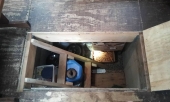Anne Miller wrote:I have lots of deer bones but they do not have much fat so I don't use them and the tallow is nasty tasting.
I completely disagree with this statement. First of all, tallow is fat and I actually really love deer tallow (I know some people don't like it but everyone should decide for themselves).
I make dozens of gallons of very rich delicious deer bone stock/broth (call it what you will) every year and have been doing so for about 10 years. I will admit though, it is not great on it's own, it needs to be made into a soup/stew or cooked with something else but it is an amazing base. In many rural areas in the US, you can get as many free deer carcasses as you want from butcher shops during hunting season. Be sure to avoid any areas close to the bullet wound as there are sure to be lots of lead particles. I like to slow roast the ribs in a pan with just salt, eat most of the meat off em and then use the bones, spine etc in my stock/broth. I always save the rendered tallow and cook with it and it's actually my favorite cooking oil. Deer heads also make an excellent extremely rich broth/stock and the tongue (once boiled) is one of my favorite pieces of meat from the entire deer. I like Sarah Milcetic's post and I have also drawn most of my inspiration from Nourishing Traditions, however my recipe is slightly less refined. This is just my basic stock/broth (not soup) recipe.
I save deer bones in the freezer until I have enough to mostly fill a big stock pot.
Put em in the pot, add water to cover, pour in some apple cider vinegar and then get em up to a boil.
I leave them on our woodstove usually for at least 3 days. We heat with wood and I try not to boil them hard, but the time they are actually simmering varies with the outdoor temp so sometimes I leave them on the stove longer.
I let the broth cool outside and them take the hardened layer of tallow off the top and save it for frying food with.
I fish the bones out with a slotted spoon and try to leave all the other stuff in there because I like my stews to be meaty.
If I have any marrow bones (leg bones), I split them open to get the marrow out and put it back in the broth.
Making sure it is room temp or cooler, I ladel it into empty yogurt containers and freeze it until I'm ready to make soup or stew. One yogurt container is a great size for a small soup and you don't even have to fully thaw it, just partially thaw it and pop it out into the pot.
I sometimes reduce the broth down longer to save on room in the freezer, then I just make sure to label it concentrated.
I never add anything besides vinegar until I am ready to turn it into a soup.
Sometimes we cook wild rice or other grains in the broth/stock, but we always have to add water when doing that as well. Makes for very rich flavored grains.
I do similar broth/stock with bird bones/carcasses and fish carcasses, pretty mush the same process but usually I don't cook them as long. The fish bones are actually edible just like in canned fish after you cook them long enough though.


















